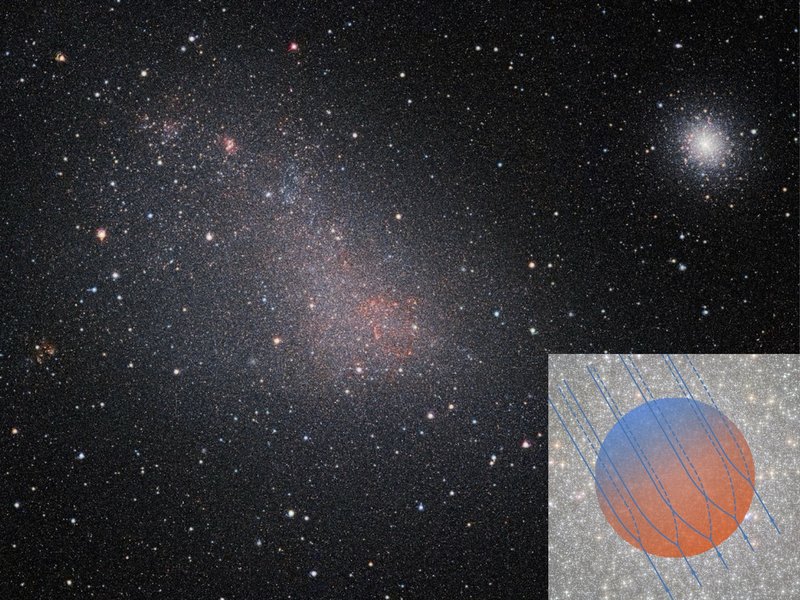Pulsars in nearby globular cluster shed light on Milky Way evolution

A distant globular cluster that's home to dozens of fast-rotating stars could provide new clues about the formation of the Milky Way and the gas halo that surrounds the galaxy.
The globular cluster, known as 47 Tucanae or 47 Tuc, is a dense collection of stars located roughly 15,000 light-years away, on the outskirts of the galactic halo that surrounds the Milky Way. Researchers estimate that this cluster hosts 25 pulsars, according to a statement from the Max Planck Institute for Radio Astronomy in Germany.
A pulsar is a rapidly spinning superdense neutron star that emits beams of radiation from two hotspots on its surface. These emissions can be observed only when a beam of radiation is pointing toward Earth, which is why the stars appear to flicker or pulse.
Related: Stunning photos of our Milky Way galaxy
Strong electromagnetic fields surround pulsars. As charged particles pass through this field, they displace electrons, which orbit the magnetic-field lines and emit radiation. By observing these spinning stars, astronomers can measure the dispersion, or frequency, of the pulses, which is proportional to the density of electrons along the path from the pulsar to Earth, according to the statement.
"In 2001, we noticed that the pulsars in the far side of the cluster had a higher dispersion measure than those in the near side, which implied the presence of gas in the cluster," study co-author Paulo Freire, of the Max Planck Institute for Radio Astronomy, said in the statement.
Using the Parkes radio telescope in Australia, astronomers measured the emissions of the pulsars in 47 Tuc, as well as the rotation of the beams of radiation as they passed through the magnetic field. Those observations suggest that the globular cluster has a surprisingly strong magnetic field that is likely amplified by galactic wind — streams of high-speed charged particles blowing out of galaxies, according to the statement.
Get the Space.com Newsletter
Breaking space news, the latest updates on rocket launches, skywatching events and more!
"The pulsars in this cluster can give us a unique and unprecedented insight into the large-scale geometry of the magnetic field in the galactic halo," lead study author Federico Abbate, also of the Max Planck Institute for Radio Astronomy, said in the statement.
Magnetic fields can affect star formation and the outflow of gas in a galactic halo. Therefore, understanding the geometry and strength of these magnetic fields helps paint a more complete picture of the Milky Way and its evolution.
The researchers plan to continue studying 47 Tuc using the MeerKAT radio telescope in South Africa, to confirm the presence of galactic wind, according to the statement.
The findings were published March 2 in the journal Nature Astronomy.
- This newfound X-ray pulsar is orbiting its partner at record speed
- Watch NASA's X-ray-hunting pulsar detector do a cosmic dance in space
- 'We Don't Planet' episode 16: pulsars
Follow Samantha Mathewson @Sam_Ashley13. Follow us on Twitter @Spacedotcom and on Facebook.
Join our Space Forums to keep talking space on the latest missions, night sky and more! And if you have a news tip, correction or comment, let us know at: community@space.com.

Samantha Mathewson joined Space.com as an intern in the summer of 2016. She received a B.A. in Journalism and Environmental Science at the University of New Haven, in Connecticut. Previously, her work has been published in Nature World News. When not writing or reading about science, Samantha enjoys traveling to new places and taking photos! You can follow her on Twitter @Sam_Ashley13.
-
rod ReplyAdmin said:A distant globular cluster that's home to dozens of fast-rotating stars could provide new clues about the formation of the Milky Way and the gas halo that surrounds the galaxy.
Pulsars in nearby globular cluster shed light on Milky Way evolution : Read more
Star clusters like globular cluster 47 Tucanae show the process of star formation operating today (e.g. M42 in Orion) is very different than in the early universe. The pulsars will spin down. The globular cluster is aging and dying. So is the entire universe.
